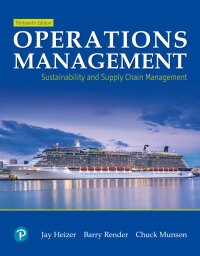1. From your knowledge of production processes and from the case and the video, identify how each...
Question:
1. From your knowledge of production processes and from the case and the video, identify how each of the 10 decisions of OM is applied at Frito-Lay. Frito-Lay, the massive Dallas-based subsidiary of PepsiCo, has 55 plants and 55,000 employees in North America. Seven of Frito-Lay’s 41 brands exceed $1 billion in sales: Fritos, Lay’s, Cheetos, Ruffles, Tostitos, Doritos, and Walker’s Potato Chips. Operations is the focus of the firm—from designing products for new markets, to meeting changing consumer preferences, to adjusting to rising commodity costs, to subtle issues involving flavors and preservatives—OM is under constant cost, time, quality, and market pressure. Here is a look at how the 10 decisions of OM are applied at this food processor.
In the food industry, product development kitchens experiment with new products, submit them to focus groups, and perform test marketing. Once the product specifications have been set, processes capable of meeting those specifications and the necessary quality standards are created. At Frito-Lay, quality begins at the farm, with onsite inspection of the potatoes used in Ruffles and the corn used in Fritos. Quality continues throughout the manufacturing process, with visual inspections and with statistical process control of product variables such as oil, moisture, seasoning, salt, thickness, and weight. Additional quality evaluations are conducted throughout shipment, receipt, production, packaging, and delivery.
The production process at Frito-Lay is designed for large volumes and small variety, using expensive special-purpose equipment, and with swift movement of material through the facility. Productfocused facilities, such as Frito-Lay’s, typically have high capital costs, tight schedules, and rapid processing. Frito-Lay’s facilities are located regionally to aid in the rapid delivery of products because freshness is a critical issue. Sanitary issues and necessarily fast processing of products put a premium on an efficient layout. Production lines are designed for balanced throughput and high utilization.
Cross-trained workers, who handle a variety of production lines, have promotion paths identified for their particular skill set. The company rewards employees with medical, retirement, and education plans. Its turnover is very low.
Step by Step Answer:

Operations Management: Sustainability And Supply Chain Management
ISBN: 9780135225899,9780135202722
13th Edition
Authors: Jay Heizer; Barry Render; Chuck Munson





